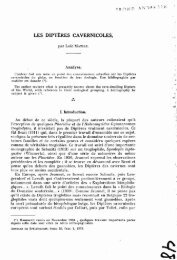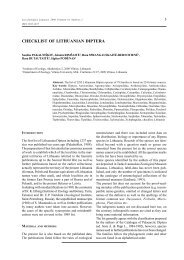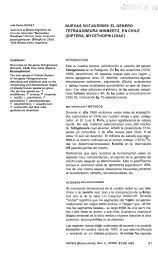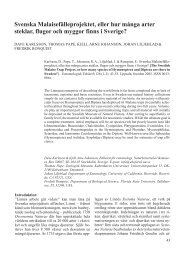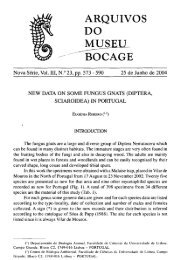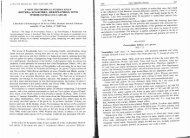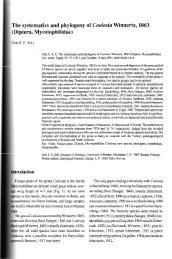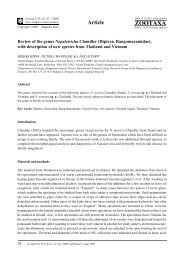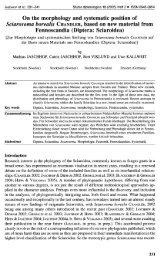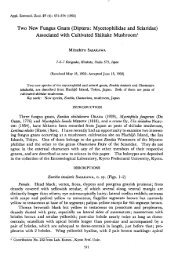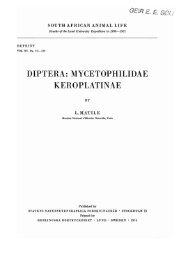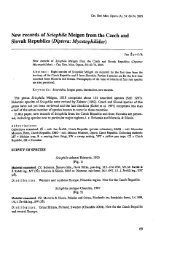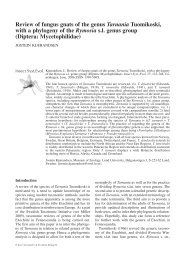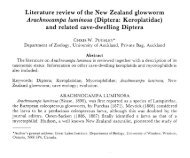Ichneumonid (Hymenoptera: Ichneumonidae) parasitoids of fungus ...
Ichneumonid (Hymenoptera: Ichneumonidae) parasitoids of fungus ...
Ichneumonid (Hymenoptera: Ichneumonidae) parasitoids of fungus ...
You also want an ePaper? Increase the reach of your titles
YUMPU automatically turns print PDFs into web optimized ePapers that Google loves.
SEDIVY & SEVCIK: 153-1 58 Studia di~terolooica l0 (2003) Heft 1 ISSN 0945-3954<br />
<strong>Ichneumonid</strong> (<strong>Hymenoptera</strong>: <strong>Ichneumonid</strong>ae) <strong>parasitoids</strong> <strong>of</strong><br />
<strong>fungus</strong> gnats (Diptera: Mycetophilidae): rearing records from<br />
the Czech Republic<br />
[<strong>Ichneumonid</strong>en (<strong>Hymenoptera</strong>: <strong>Ichneumonid</strong>ae) als Parasitoide von Pilzmiicken (Diptera:<br />
Mycetophilidae): Ergebnisse von Schlupfversuchen aus der Tschechischen Republik]<br />
by<br />
Josef SEDIVY and Jan SEVCIK<br />
Prague (Czech Republic)<br />
Ostrava (Czech Republic)<br />
Abstract<br />
Key words<br />
Twenty-one species <strong>of</strong> lchneumonidae from the subfamilies M~croleptinae and Orthoccntrinae<br />
were reared from fungi. together with their potential hosts, <strong>fungus</strong> gnats (Mycctoph~l~dae).<br />
Samples <strong>of</strong> fungi infested by dipterous larvae were collected in the ycars 1998-2000 at various<br />
localities <strong>of</strong> the Czech Republic. Of the 177 samples <strong>of</strong> fungi infested by mycetophilids, 44<br />
(24.9 "") were parasitized by ichncumonids. A list <strong>of</strong> ichneumonids identified to species is<br />
provided, together with data on habitat, host insect and host <strong>fungus</strong>. Host insect is recorded for<br />
the first time for 17 ichneumonid species. Sixteen species and 4 genera <strong>of</strong> lchneu~nonidae are<br />
recorded for the first time from the Czech Republic.<br />
<strong>Ichneumonid</strong>ae, Mycetophilidae, host records, host fungi, Czech Rcpublic<br />
Zusammenfassung lnsgesamt 2 1 Arten von <strong>Ichneumonid</strong>en aus den Untcrfaniilicn der Microleptinac und dcr<br />
Orthocentrinae wurden gcmeinsam mit ihren potentiellcn Wirten unter den Pilzmuckcn<br />
(Mycetophilidae) aus Pilzfruchtkorpern geziichtct. Proben von Pilzen, die von Dipterenlarven<br />
befallen warcn, wurden in den Jahren 1998-2000 an verschiedenen Fundortcn in der Tschechischen<br />
Republik gesarnmelt. Von den 177 Proben der von Pilzmucken befallenen Fruchtkorper<br />
waren 44 (24.9 4;) von lehneumoniden parasitiert. Es wird eine Liste der bis zuln Artnit<br />
eau determinierten Schlupfwcspcn zusammen mit Daten zurn Habitat, den Wirtsartcn und<br />
den Pilzarten gegeben. Die Wirte der Wcspen werden ttr 17 <strong>Ichneumonid</strong>cn-Arten erstmals<br />
hcnannt. Bei 16 Arten von <strong>Ichneumonid</strong>cn aus 4 Gattungen handclt cs sich um Erstnachweise<br />
fiir die Fauna Tschechischen Republih genieldet.<br />
Stichworter<br />
Ichncumonidae, Mycetophilidae, Wirte, Nachweise, Pilze, Tschechische Rcpublih<br />
Introduction<br />
<strong>Ichneumonid</strong>s (<strong>Hymenoptera</strong>: <strong>Ichneumonid</strong>ae) from the subfamilies Oxytorinae and<br />
Orthocentrinae are known as larval <strong>parasitoids</strong> <strong>of</strong> <strong>fungus</strong> gnats (Diptera: Sciaroidea), especially<br />
<strong>of</strong> the family Mycetophilidae. These two subfamilies <strong>of</strong> <strong>Ichneumonid</strong>ae have been rather<br />
neglected up to the present and host records for particular species are very sporadic. KOLAKOV<br />
& BECHEV (l 995) summarized almost all available data about hymenopterous <strong>parasitoids</strong> <strong>of</strong><br />
<strong>fungus</strong> gnats, including also Braconidae and Proctotrupoidea (<strong>Hymenoptera</strong>). These authors<br />
listed 6 genera <strong>of</strong> <strong>Ichneumonid</strong>ae as <strong>parasitoids</strong> <strong>of</strong> <strong>fungus</strong> gnats: Aniser's F~RSTER, 1871;<br />
Aperileptus FORSTER, 1869; Entypoma F~RSTER, 1868; Orthocentr~ls GRAVENHOKST, 1829;<br />
Plectiscidea VIERECK, 1914 and Proclitus HALIDAY, 1838.<br />
The Mycetophilidae is a species-rich family <strong>of</strong> Diptera with more than 1200 described<br />
Palaearctic species. The larvae <strong>of</strong> most species are more or less associated with fungi. All<br />
known larvae <strong>of</strong> the subfarnily Mycetophilinae are considered mycetophagous, feeding usually<br />
inside the fruiting bodies <strong>of</strong> various species <strong>of</strong> macr<strong>of</strong>ungi. Several genera <strong>of</strong> <strong>fungus</strong>
P-<br />
SE~IVY & SEVCIK lchneumon~d parasltoids <strong>of</strong> <strong>fungus</strong> gnats rearing records from the Czech Republ~c<br />
gnats are surface feeders. Both polyphagy and oligophagy have been reported (cf. e.g. CHAN-<br />
DLER 1978, YAKOVLEV 1994). Pupation usually takes place in the groilrid but some Mycetophilinae<br />
pupate in the host <strong>fungus</strong>. Fungus gnats are most abundant In humid areas, especially<br />
moist woodland. During the day adults <strong>of</strong> many specles congregatc in inoist dark<br />
places such as overhanging stream banks and cavit~es under tree roots (SOLI et al. 2000).<br />
In this paper, new rearing records from the Czech Republic arc prescnted. For each ichneumonid<br />
species listed bellow, a brief character~st~cs <strong>of</strong> the locality and thc specific name <strong>of</strong> both host<br />
<strong>fungus</strong> and the mycetophilid host are prov~ded.<br />
Material and methods<br />
All material for this study has becn rcared by the second author from fungi. The samplcs were<br />
collected in the years 1998. 1999 and 2000 in various habitats in the Czech Republic, mainly<br />
beech forests and pond dams with oak trees. The method <strong>of</strong> rearing is principally described by<br />
L,ui-ov~.~ (197 1) and HACKMAN & MEINANDER (1979). Most <strong>of</strong> the material examined is preserved<br />
in the authors' private collections, its minor part also in the Silesian Muscuin (Opava.<br />
Czech Rcpublic) and the Research Institute <strong>of</strong> Crop Production (Prague, Czech Republic).<br />
The first author <strong>of</strong> this paper identified the emerged adults <strong>of</strong> <strong>Ichneumonid</strong>ac and is responsible<br />
for the data concerning their distribution and biology. The second author provided all<br />
data about the hosts, methods and localities. Grid mapping field codes are given according<br />
to PRUNER & MIKA (1997).<br />
Results and discussion<br />
Degree <strong>of</strong> parasitism<br />
Altogethcr 177 samples <strong>of</strong> fungi infested by ~nycetophilid larvae were collected in the years<br />
1998-2000 and 44 <strong>of</strong> them (24.9 %) were parasitized by ichneurnonids. Species-rich genera<br />
Mycetophila METGEN. 1803 and Allodin WINNERTZ, 1863 have been most <strong>of</strong>ten attacked.<br />
Suitable quantitative data for comparision <strong>of</strong> degree <strong>of</strong> parasitism <strong>of</strong> ichneumonids in <strong>fungus</strong><br />
gnats are not available. although many authors studied associations <strong>of</strong> <strong>fungus</strong> gnats with fungi.<br />
The possible reason is a relatively difficult identification <strong>of</strong> hymenopterous <strong>parasitoids</strong>. Also<br />
for other parasitic <strong>Hymenoptera</strong>, such as Braconidae, these quantitative data are very sporadic<br />
(cf. YAKOVI,FV & TOH~~S<br />
1992).<br />
Host fungi<br />
The ichneumonid species listed below were reared from 20 spccies in 16 genera and 10 families<br />
<strong>of</strong> fungi (see list at the end <strong>of</strong> this paragraph). The most frequent genus <strong>of</strong> fungi in the parasitized<br />
sarnples was Russula. All but one species <strong>of</strong> the host fungi belong to the class Basidiomycetes<br />
(both Aphyllophorales and Agaricales rcpresented), one sample to Ascomycetes.<br />
ASCOMYCETES. Pcziraceac: Pezizu spcc. BASIDIOMYCETES. Aphylluphorales. Tlielenhoraceae: H\,rln~tnz<br />
repnnd~rm L. Bondarzewiaceae: Bondarzewiu riicsc~ritcricu (SCHAFF~.) KRLI~LL l = B. 11101rrri11
Studia dipteroloqica 10 (2003) Heft 1 : 153-1 58<br />
Survey <strong>of</strong> <strong>parasitoids</strong> reared<br />
Altogether 2 1 species belonging to 9 genera <strong>of</strong> <strong>Ichneumonid</strong>ae were reared from lnycetophilid<br />
larvae and identified to species during this study. Several specimens. however, still remain<br />
unidentified especially those where both males and females have not been obtained.<br />
A particular record is given in the following order: specific name <strong>of</strong> a parasitoid, sampling<br />
locality. grid mapping field code (in parentheses), habitat, collecting date, emerging date. number<br />
<strong>of</strong> males and females examined, specific name <strong>of</strong> dipterous host and specific (or generic) name<br />
<strong>of</strong> host <strong>fungus</strong>. The species new for the fauna <strong>of</strong> the Czech Republic are marked with an asterisk.<br />
MICROLEPTINAE<br />
Hyperacmus crassicornis GWENHORST, 1829<br />
Material examined. Moravia & S~les~a, Moravskoslezske Beskydy Mts., Bila, Velka Smradlava valley (6476), spruce<br />
forest. 17.9.2000, 7.10.2000, 2 o" 6, 5 9 9. ex "Scioplzilo vuria (M'I~N~KIL, 1863) in Hvrlrzrr~~r r~punduflr.<br />
This species has not yet bcen stated among the <strong>parasitoids</strong> <strong>of</strong> <strong>fungus</strong> gnats<br />
*Aniseres pallipes FORSTER, 1871<br />
Material examined. Moravia & Silesia, Polanka nad Odrou (6275), pond dam. 29.10.1999 19. 23.1 1.1999, 4d 5.<br />
19. cx Mycetophilu fungorum (Dc Gc~R. 1776) in E~rtoloma nirloi-o.suni. - Moravia & Silesia. Vrbno pod Pradidem,<br />
Vidly, beech forest (5869), 19.7. 2000,4.-.5.8.2000,2 d d , 1 P ex Mvcetophila r.~!/icollis group in Luctu~.iu.s ichor~/rt.\,.<br />
Accord~ng to KOL-\KOV & BLCHEV (I995), this ichneumonid specics has already been reared from M~~crto~pl~il<strong>of</strong>i~ngcir.rttn<br />
and ,2~l~~c~cto/~/riI(z /bi-cipatcr LUNDSTR~IM, I9 l 3. .4tziser~~~.s<br />
a new genus for the fauna <strong>of</strong> the Czech Republic<br />
Aperileptus albipalpus (GRA\JENHORST, 1829)<br />
Material examined. Moravia & Silesia, Krnov-Cvilin, Hajnicky potok vallcy (5972), spruce forest, 25.7.2000,<br />
11.8.2000, 1 P. ex Myc~~/upl~ilo ulco L ~ FFOO~, 1965 in Ru.s.sulo ~ti,yricuns.<br />
This species was recorded for the first time from thc Czech Republic already by LL$I.O~KA (1971). who had reared it<br />
from Mj~c,etophila fui~gortiric. but this record was overlooked and not included in the checklist by ~~nivv (1989).<br />
.i/~,cetoj~hiln crleu LAFFOOU. l965 (= M grtttcrta DZI~L)LICKI, 1884) was stated as the host <strong>of</strong> A nlhi/i(rlpu.v already by<br />
TH(~MPSOV (1957).<br />
*Aperileptus microspilus FORSTER, 1871<br />
Material examined. Moravia& Silesia, Vitkov-Podhradi (6172). mixed submountain forest. 5.9.1998,23. 25.9.lYOX.<br />
I d. I ? , cs ,2~lvc~c,to/~/ril~r trlea in R~~ss~lla nigr-iccrrrs.<br />
The hosts <strong>of</strong> this species have not yet bccn reported.<br />
*Aperileptu.s plagiatus FORSTER. 1871<br />
Material examined. Morav~a X S~les~a,<br />
c,vunid(i L ~STOLKA, 1972 In RLI\ T I I I 111teut
SEDIW & SEVC~K: <strong>Ichneumonid</strong> . ... <strong>parasitoids</strong> <strong>of</strong> <strong>fungus</strong> gnats ... :rearing records from the Czech Republic.<br />
--p. . .- ..-.pp .<br />
ROVAN (l 923) and VAN ROSSL~I (l 988) recordcd Dynuto.rornu,fu.scicor~ze (MEIGFN. 1818) as a host fly <strong>of</strong> this species.<br />
KOLAKOV & BE( t ~ (l ~ 995) v added as a host also Myc.etop-,hila ulcu. Entjportrn IS a new genus for the fauna <strong>of</strong> the<br />
Czcch Republic.<br />
*Entypoma suspicio.suttl (FORSTER, 1871)<br />
Material examined. Moravia & Silesia, Dolni Lomna (6478), fir-beech forest, 24.9.2000, 10.10.2000, 16.29 P, ex<br />
M~)c,etophila spec. (probably 12f. cingulurrr MFIGEU, 1830, adults ha\e not been reared only larmc studied) 111 Pollporr~.s<br />
sq~runzo.~us. Moravia & Silesia, Ostrava-Michalkovice (6176), recultivated mine dump, 24.4.1999,6.-7.5.1999,2cS 3.<br />
reared together with Al/odiu orntrticol1i.s (Mtlti~u, 1818) and Exechitr .sj~inuligeru Luunsrno~. 1912.<br />
1 P,<br />
The hosts <strong>of</strong> this ichneumonid arc recorded here for thc first lime.<br />
*Hemiphanes gravator FORSTER, 1871<br />
Material examined. Moravia & Silcsia, Polanka nad Odrou (6275), Blucheruv les, floodplain forest, 26.6.1999.<br />
9.7.1999, 2d 6, rearcd together with Ditomyin,firsc~iutu (MLI~IFN, 1818) (Ditoniyiidae), Ulu holitophil~z LOLW, I 869<br />
(Pediciidae). ..lgrrthomyiu untenutu (ZFTT~KSTLL)T, l 8 19) (Platypezidae) and Megtr.~eliu ,fi.anierrtrt Sc livnz, 1927<br />
(Phoridae) from kljerkunileru adu.st~t The other potential host: Myceto/~/rila spec. (possibly M trinotutrr STAFGFR,<br />
1840, only larvae obtained).<br />
Bjerkurideru ndristtr is one <strong>of</strong> the most attractive species <strong>of</strong> fungi for insects (cf. Y.\KOVI.FV 1994, SLV~<br />
ih 2001) and<br />
this makes problems with the identification <strong>of</strong> real host <strong>of</strong> this ichneumonid specics. Considering the fact, that the<br />
larvae <strong>of</strong> Megtrseliu and Aguthomyicr are rather small, and, on the othcr hand, those <strong>of</strong> Ulu rathcr large, thc most<br />
probable hosts were in this case Ditoniyicr,fu.sciuta aiid hfl.cctophilu spec., especially when no adult specimens <strong>of</strong><br />
AMycetophiln emerged. Hem/phurzc.s is a new genus for the fauna <strong>of</strong> the Czech Republic. H. gruvator has hitherto<br />
been known from Austria, Germany aiid Sweden ( V~N ROSS~M 1987).<br />
Orthocetitrus asper (GRAVENHORST, 1829)<br />
Material examined. Moravia & Silesia, Studknka (6274), pond dam, 1.8.1999~18.8.1999~ 13, ex Sciophila Irireu<br />
Macquart, 1826 on Rzi.ssrilti lu~eotuc~cr.<br />
Three other species <strong>of</strong> 0rlhocentrlr.s have becn recorded in the literature (KOL.AKOV & BECHFV 1905) as <strong>parasitoids</strong> <strong>of</strong><br />
thc genus Sciophiltr MFIG~N. 1818. Larvae <strong>of</strong> Sciophi/o are usually surface feeders on various species <strong>of</strong> fungi and<br />
they spin characteristic webs and cocoons in which pupation takes placc.<br />
*Pantisarthrus luridus F~RSTER, 1871<br />
Material examined. Moravia & Silesia, Moravskoslezske Beskydy, Bila. Velk6 Smradlava valley (6476). mixed<br />
forest (spruce and beech), 9.8.1998, 26.8.1998. 268,<br />
reared together with G1rdr.1~ ni~idulir EDWAKDS, 1925 and<br />
Cordyla firscu MFIG~N 1804 from Ru.s.sztla spec.<br />
According to VAN ROSSEM (1987), thi:, is a common species. Its biology, however, has not heen recorded up to the<br />
prescnt. The genus Punli.sto-t1rru.s is new for the fauna <strong>of</strong> the Czech Republic.<br />
*Plectiscidea agitator (FORSTER, 1871)<br />
Material examined. Moravia & Silesia, ~ilheiovice (6075), beech forest, 27.7.1998, 9.- 12.8.1998, l d, 29 9, ex<br />
Allodirr grrrlu (MLKILN, 1830) in Pluleus spec.<br />
This species was recorded from Germany by VAY ROSSL~I ( 1987). Its hosts have not becn reported ao hr.<br />
Plectiscidea canaliculata (FORSTER, 1871)<br />
Material examined. Morac~a & S~lesia, Ostrava-Tiebovlce (6175), town park. 22 5 1999, 10 6 1999, 463, l?, ex<br />
Allodra ptirra In Culocyhe gumhostr<br />
This species is kno\rn from Austr~a. the Czech Republic and Germany (V.\> Ross~~<br />
1987). Its hosts have not been<br />
recorded.<br />
*Plectiscidea cinctula (FORSTER, 1871)<br />
Material examined. Moravia & Silcsia, Vrbno pod Pradedem env.. Jeleni bukina Nature Reserve (5869). 900 m,<br />
maple-bcech forest. 4.9.1999124,-25.9.1999. 1 P, ex Allotlirr fbli~frrrr (STRORL, 1910) in Pc~izo spec.<br />
VAU ROSSLM (1987) recorded this specics frorn Austria, Germany and Sweden. Host insects have not bcen recorded<br />
up to thc present.<br />
*Plectiscidea collaris (GRAVENHORST, 1829)<br />
Material examined. Moravia & Silesia, Studcnka (6274), pond dam, 24.10.1999'1 4.1 1.1999, l d. I P, reared together<br />
with Myccropl~il~ fungorum, E.~rclricr$r.scu (MLICLN, 1804) and Allodia or.rzrrticolli.r frorn Hebelonru cr.u.s!uliwiforme. -
pp--p-----------<br />
Studia dipterolog~ca 10 (2003) Heft 1: 153-158<br />
Moravia & Silesia. Polanka nad Odrou (6275), pond dam, 29.10.199%/19.-22.11.1999. HIS d. 3 Y Y. ex .l.l~~cvtophiln<br />
firngo~rinr in Oitolon~n i~ition~.s~irn.<br />
This species is reliably known from Germany. Italy and the Nerherlandb (VAX RIJSSL~I 1987). Its hosts have not been<br />
recorded.<br />
*Plectiscidea deterior (FOKSYEK, 1871)<br />
Material examined. Moravia & Silesia, Sludkirka (6274). pond dam uith hornheam trces, 6. 10. 2000129.10.2000,<br />
1 F, 1 P. ex .lllodio~),~i.v spec. in Clitoc?.hr odonr.<br />
I-h~spccics has so far bcen rccorded from Austria and Cjermany (V.m ROSSL'VI 1987). Males and host insects have<br />
been unknown up to the present.<br />
* Pl~ctiscidea monticola (F~RSTER, 1871 )<br />
Material examined. htoravia & Silesia, Vitkov-Podhradi (61721, mixcd submountain forest. 6.6 1'~99i71.6.1'~99,<br />
1 5, ex hf!c.iztol,liilu spec. (~.i!/ico/lis group, only fernnles obtained) in Col(~,hirr c.oi!fl~~~~i.s.<br />
Van Rossc~ (1987) recorded this ~pecies from Germany, Switrerlalid and Sweden. Thc biology <strong>of</strong> tliih species has<br />
not been recorded so far.<br />
*Plectiscidea vagator (FVHSTER 1871)<br />
Material examined. Moravia & Silesia, ~lval~ro (5972). ~nixed forest. 27.6.1')')9/9.7.1999, 1 i, reared logether with<br />
.-lllodil~ or-ricitic~ol1i.s and Eret,hicr spec. from Ilfr'cenrr pzrrtr.<br />
blalc <strong>of</strong> this specizs remains unknown. Females ore known from Germany. Switzerl;lnd and Italy ( V~N Rosstlil 1087).<br />
Matcrial csarnined. bloravia R: Silcsia. Moravin & Silesia. Moravskoslezsk~ Ueskydy Mts.. Bila. Velki Srnradla\a<br />
valley (6476). spruce forest, 17.9.2000. 3.10.2000, 2d$, reared together with Alloiiiu rriitz'vi KL;RIN~. 1998 and<br />
Cor~/~./u,/ii.scir Mtici~~, 1804 from RLO..PLL/(I p~l~ldu.~~.<br />
This species has hitherto been known from Ireland, Ciermany, Sweden and the Netherlands (VAN ROSSLM 1083).<br />
Boli/ophilu glrrh~.(itu LOL-IV, 1869 (D~ptcra: Bolitophilidae) was recorded as host <strong>of</strong> this ichneu~nonid species in the<br />
liternture (cf KoL,\Ro\' RL RFCHLV 1905).<br />
*Proclitus praetor (HALIDAY in CIIR.~IS, 1839)<br />
Material examincd. Morav~a & Silc~ia. Silliciovice (6075), beech forest, 3.7.1990. 18.-22.7.1090, -Id 6, 1 V , cx<br />
bf~.crtophilo fioijior.rim in Rri.s.srilrr spec. Moravia & Silesia, Studenka (6274), pond darn, 25.8.19'19, 9.9.1999. 1 2,<br />
reared together with ~~~c~etoj)hilnfirnfiorr~iii and Allodiu ovnutrcnllis from Pantli~~i.elln cni~~fi~llcu~~u. Moravia RL Silesia,<br />
Moravskoslezskc Ueskydy blts., Bili. \fclka Smradlava valley (6476); spruce forest, 17.9.2000, 8.10.2000. 1 9. ex<br />
M~~cctophilnjinlonrlic~rr Ena,4nns, 1013 in Tricho1orrropsi.s dec,oru. Moravia & Silesia, 'vloravskoslczske Ueskydy<br />
Mts., Bil5, Velka Slnradlava valley (6476), spruce forest, 17.9.2000, 7.-9.10.2000, 460. 39 0. ex M~,c.etophiln<br />
This ichneumonid species IS probably rather corllrlloll and is known from many European countries (V\N ROSS~M<br />
1983). Its Irosts, however, are publistled herc for the firsi time and a preference for larger species <strong>of</strong> ,h,[~rcrophiln is<br />
apparent.<br />
*Proclit~rsuhsulcatits FORSTER, 1871<br />
Material examined. Moravia & Silcsia, Brumovice-Pocheli (5972). mixcd forest, 24.7.1999!10.8.1990, 1 c?, reared<br />
togcther with .M~cero~)hil~r,firrigo~'~rrn, Cbr(l~,ltr niticiul[r and Lr/[r g./i~rticn (MIIGLY, 1 X 18) from RIIS~SIIIN c:~~crno,r(~~it/i~.<br />
Only one male Iholotype) from Germany has been known up to the present. wirhout ;my data concerning ~ ts biology.<br />
Females l~ave not yet been associated.<br />
Faunistic remarks<br />
In the checklist <strong>of</strong> <strong>Hymenoptera</strong> <strong>of</strong> the former Czechoslovakia (S~u1v.i 1989), 7483 species<br />
<strong>of</strong> <strong>Hymenoptera</strong>, including 1957 species in 420 genera <strong>of</strong> <strong>Ichneumonid</strong>ae, were recorded.<br />
Many species, however, are only listed from the major parts <strong>of</strong> the former Czechoslovakia<br />
(i.e. Bohemia, Moravia & Silesia and Slovakia) without precise locality and the other relevant<br />
data. Moreover, only about two thirds <strong>of</strong> the real number <strong>of</strong> species occuring in this<br />
country were published in this checklist and many species thus remain unrecorded.
SEDIW & SEVC~K: <strong>Ichneumonid</strong> - ... parasdo~ds <strong>of</strong> <strong>fungus</strong> pats ... :rearing records from the Czech Republic.<br />
That is why almost all species <strong>of</strong> Ichneu~nonidae recorded within this study are new for the<br />
Czech Republic. Four <strong>of</strong> the 9 genera recorded above (Aniseues, E~~l]llpon~u, Hemiphanes and<br />
Pantisai.thus) are for the first time recorded from this country.<br />
On the other hand the faunistic research <strong>of</strong> the order Diptera in the Czech Republic is<br />
relatively more advanced. Only one species <strong>of</strong> Mycetophilidae stated as host <strong>of</strong> ichneumonids<br />
in this study (Sciophila var-ia) has not yet been reported from the Czech Republic.<br />
Acknowledgenients<br />
Wc are grateful to the mycologists Vit RALNLK (Opava. Crcch Republic) and Michal GKA~%<br />
(Ostrava, Czech Republic)<br />
for their help with the identification <strong>of</strong> host fungi.<br />
Literature<br />
CH\NDI.EK. P. J. (1980): Associations uith plants. Fungi. - In STUHI~S. A. & CH!\UDI.FR, P. J. (eds): .A Diptcrist's<br />
Handbook. - .Alnatcur Entomologist 15: 199-211: Middlcscx: The Amateur Entomologist's Society.<br />
HKKMAN, W. & MLIUA~DFK, M. (1979): Diptera feeding as larvae on rnacr<strong>of</strong>ungi in Finland. Annales Zoologici<br />
Fennici 16: 50.~83; Helsinki.<br />
KOLAKOL, J. & BFCII~V, D. (1995): Hyrnenopterenparaalten (<strong>Hymenoptera</strong>) auf Pilzmiicken (Mycctophiloidea, Diptera).<br />
- .Acts Entomologica Uulgarica 2: 18-20: S<strong>of</strong>ia.<br />
L,LSIOVK~. P. (1971): A study on the last instar larvne <strong>of</strong> some Czechoslovak M~rc~toj~kilrr (Diptera, Mycetophilidae).<br />
- Acta Universitatis Calolinae - Biolo_rica 1970: 137-17-1; Praha.<br />
PKI~PR. L. & M~KA P. (1996): List <strong>of</strong> seltlements in the Czech Republic with associated map field codes for faunistic<br />
grid mapping system. - Klapalekiana 32 (Suppl.): 1-175; Praha.<br />
ROM\U. A. (1923): lchncurnonids reared from Diptera Nematoccra. - Entomologi~t's Monthly Magazlne 59: 71 -76:<br />
\Vallingford.<br />
ROSSLM, G. \IN (1083): A revision <strong>of</strong> western palaearctic Oxytorine genera. Part 111. Genus Proclir~r.\. (Hymenoptem.<br />
Ichneumnidae). - Contributions <strong>of</strong> the American Entomological lnstitutc 20: 153-1 65; Gaincsville, Fla.<br />
ROSSLM, G. \AN (1985): A revision <strong>of</strong> Wcstern Polaearctic Oxytorine Genera. Part V. Genus Aperilepttrs (<strong>Hymenoptera</strong>.<br />
<strong>Ichneumonid</strong>ae). - Spixiana 8: 145l52: Miinchen.<br />
Rosst~, G. V.\N (1987): ,A I-cvrsion <strong>of</strong> western palacarctic Oxytorine gcncra. Part VI. (Hy~ncnoptera, <strong>Ichneumonid</strong>ae).<br />
- Tijdschrift voor Entomologie 130: 49-108: s'Gravcnhage.<br />
SE~I\,Y. J., ed. (1989): Check list <strong>of</strong>Czechoslo\~ak Insects 111. (<strong>Hymenoptera</strong>). Acta Faunistica Entolnologica Musei<br />
Nationalis Prngae 19: 1-196: Praha.<br />
~t\~i.i~, J. (2001 ): Diptel-a (excluding Mycetophilidac S. str.) associated vith fungi in Czech and Slovak Republics: a<br />
survey <strong>of</strong> rearing records from 1998-2000. - Acta Universitatis Carolinae - Biologica 15: 157-168; Praha.<br />
SOLI, G. E. E.; VOCKLKOTH, J. R. & .~II\IILL, L. (2000): Falnilies <strong>of</strong> Sciaroidea. Pp. 49-92 in: P,%PP, L. & DAR\.SS, U.<br />
(cds): Contributions to a Manual <strong>of</strong> Palaearctic Diptera (with special reference to fl~es <strong>of</strong> ccono~nic importance).<br />
Appendix; Budapest: Science Herald.<br />
THOMPSO~, W. R. (1957): A catalogue <strong>of</strong>the parasitcs and predators <strong>of</strong> insect pests. Section 2. Part. 4. Pp. 333-561 ; Ottawa.<br />
Y.\KOVLLV, E. B. (1994): Palaearctic Diptcra associated with fungi and hlyxomycctcs. - Karelian Rescarch Center,<br />
Russian Academy <strong>of</strong> Sciences. Forest Research Institi~tc. Petrozavodsk.<br />
Y.~M)\,LL\:, E. B. & TOUIA\. V. 1. (1992): Braconidae (<strong>Hymenoptera</strong>) parasites <strong>of</strong> tirngivorous Diptera in Karelia.<br />
Entomologica Fcnnicn 3: 139148; Helsinki.<br />
Authors' addresses<br />
Josef SEDIVY<br />
Jan SEVC~K<br />
Research Institute <strong>of</strong> Crop Production Horymirova 39 121104<br />
Drno\ska 507 CZ-700 30 Ostrava 30<br />
CZ-16 1 06 Praha 6 - RuzynE<br />
Czech Republic<br />
Czech Republic<br />
.I he paper was accepted on 10 October 2002<br />
Editurn: 15 December 2003.



